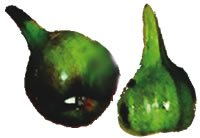
Dimdima
Online Children's Magazine from India

Dimdima
Online Children's Magazine from India

The bamboo belongs to the grass family, and because of its size is sometimes called tree grass or ‘elder brother of grass’. There are over a thousand species of bamboo, worldwide. One species found in India is Melocanna baccifera (Muli bamboo), which grows abundantly in Mizoram and other parts of the northeast.
This species of bamboo flowers once in 48 years or so. One would think people would look forward to this rare flowering. But they don’t. They dread it.
They consider the flowering as a bad omen. There’s a saying in Mizoram: “When the bamboo flowers, famine, death and destruction follow.”
Famine followed bamboo flowerings in 1862, 1881 and in 1911-12.
 The famine associated with the last flowering in 1959 caused so much distress that it resulted in an armed uprising by the Mizo National Front (MNF), a conflict that lasted 20 years.
The famine associated with the last flowering in 1959 caused so much distress that it resulted in an armed uprising by the Mizo National Front (MNF), a conflict that lasted 20 years.
Once a bamboo tree has produced flowers its life’s work is over and it dies soon afterwards.
The Muli flowers around the 48th year of its life; other species flower in their 15th year or 20th year or even in their 3rd year or even after a year. Some species flower after a century. But all members of the same species flower at the same time, wherever they may be.
The mass flowering of some species is considered ominous not only in Mizoram but also in other parts of the northeast, and other countries of Asia.
In Bangladesh for example, famine invariably follows the flowering of the Bambusa tulda species of bamboo, which like the Muli has a 48-year flowering cycle. In southern China the mass flowering of thorny bamboos is believed to cause floods or drought.
Bihu songs from Assam refer to bamboo flowering as a precursor of bad harvests and epidemics.
The famines can be explained as being due to increased consumption of grain by rats. The flowering of the bamboos leads to the production of large quantities of fruits and seeds. The seeds cover the forest floor and provide an easily available source of nutrition for rats. They multiply rapidly and spread across the countryside. When the seeds are consumed they raid the rice fields and granaries and devour vast quantities of grain. The result is famine.
The Mizoram government has taken steps to ensure that the flowering of the Muli bamboo does not result in famine this time.
Last updated on :8/14/2006
EXPLORE MORE...
COMMENT ON THIS ARTICLE
Wants to share something related to this article? Please use the form below.
Dimdima is the Sanskrit word for ‘drumbeat’. In olden days, victory in battle was heralded by the beat of drums or any important news to be conveyed to the people used to be accompanied with drumbeats.
Bharatiya Vidya Bhavan
K. M Munshi Marg,
Chowpatty, Mumbai - 400 007
email : editor@dimdima.com
Bharatiya Vidya Bhavan
505, Sane Guruji Marg,
Tardeo, Mumbai - 400 034
email : promo@dimdima.com
Dimdima.com, the Children's Website of Bharatiya Vidya Bhavan launched in 2000 and came out with a Printed version of Dimdima Magazine in 2004. At present the Printed Version have more than 35,000 subscribers from India and Abroad.